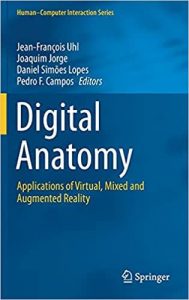
Digital Anatomy: Applications of Virtual, Mixed and Augmented Reality
New book brings together 2 INESC-ID researchers: Joaquim Jorge and Daniel Lopes and other specialists in a unique interdisciplinary work

The first book on digital anatomy, written in close cooperation between doctors, anatomists, and computer scientists, addresses Extended Reality applied to Clinical and Surgical Practice through Training and Teaching.
The book just published by Springer / Nature’s prestigious series of books “Human-Computer Interaction Studies”, edited by two INESC-ID/Tecnico Professors, Joaquim Jorge and Daniel Lopes of Department of Computer Engineering and INESC-ID / Lisbon, in collaboration with Professors Jean-François Uhl of the University Paris-Descartes and Pedro Campos (University of Madeira). The book clarifies the classic approaches with VR, AR, and MR; It presents recent VR, AR, MR systems, techniques, and methods for digital anatomy.
This book offers readers new insights into extended reality to digital anatomy, a new emerging discipline. The way teachers teach anatomy in the classroom is changing rapidly as new technology-based approaches become increasingly accessible. Recent studies show that Virtual (VR), Augmented (AR), and Mixed-Reality (MR) can improve retention andlearning outcomes.
“The book is aimed at the scientific, academic and professional research community. It can be used as a textbook, “survey” on the state of the art and seed for new research projects”, says Joaquim Jorge, one of the authors and researcher at INESC-ID.
Readers will find relevant tutorials on three-dimensional reconstruction techniques to perform virtual dissections. Several chapters serve as practical manuals for students and trainers in anatomy to update or develop their digital anatomy skills. We developed this book as a support tool for collaborative efforts around Digital Anatomy, especially in international and interdisciplinary distance-learning contexts. Our goal is to leverage the source material in this book to support new digital anatomy courses and programs in interdepartmental and interdisciplinary collaborations.
A work carried out by several hands that resulted in an unusual book that brings together specialists in Anatomy, Informatics and Medicine.
“The idea came from a collaboration with my colleague Jean-François Uhl that I had the opportunity to meet at a congress organized in Lisbon”, says Joaquim Jorge. “Me and my colleague Jean-françois Uhl were instrumental in exercising the network of contacts that each one of us has in their respective fields and collecting chapters. Daniel Lopes and Pedro Campos helped to recruit reviews and in the process of writing and editing some chapters ”, adds the researcher.
Joaquim Jorge also tells us how the idea for this book was born:
“This book came from an idea of mine. I organized the proposal given the experience of writing and editing books for Springer / Nature (it is already the 4th). The proposal was drawn up in 2018 and accepted in 2019. In 2019/2020 we have collected chapters around the world and 2020/2021 were spent on reviewing and reviewing chapters (where Daniel and Pedro Campos helped a lot). The book came out after a seven-month marathon (I planned to finish it on my sabbatical, but the pandemic delayed the process”.
The book was just launched and more information can be found at https://www.springer.com/gp/book/9783030619046
“I am very happy with the range of knowledge, skills and approaches that we have gathered in this book, with contributions of great technical level and thematic diversity, which I hope will stimulate / catalyze new lines of research and teaching”, pointed out Joaquim Jorge
Upcoming Events
NII International Internship Programme Presentation and Q&A by Emmanuel Planas

On April 30, Emmanuel Planas, the acting director of the Global Liaison Office (GLO) and responsible for the internationalisation program at the National Institute of Informatics (NII) in Tokyo, Japan, will give a presentation to introduce the NII and its internship program to INESC-ID students and IST’s Master’s in Computer Science students.
Date & Time: April 30, 14h00
Where: Sala Polivalente, Técnico – Taguspark
“The NII International Internship Program is an exchange activity with students from institutions with which NII has concluded a Memorandum of Understanding (MOU) agreement. This incentive program aims at giving interns the opportunity for professional and personal development by engaging in research activities under the guidance and supervision of NII researchers.
The NII Internship Program is open to Research Master’s and PhD students who are currently enrolled at one of the partner institutions that have signed an MOU agreement with NII.”
Educational Workshop on Responsible AI for Peace and Security (UNODA)

On June 6 and 7, The United Nations Office for Disarmament Affairs (UNODA) and the Stockholm International Peace Research Institute (SIPRI) are offering a selected group of technical students the opportunity to join a 2-day educational workshop on Responsible AI for peace and security.
The third workshop in the series will be held in Porto Salvo, Portugal, in collaboration with GAIPS, INESC-ID, and Instituto Superior Técnico. The workshop is open to students affiliated with universities in Europe, Central and South America, the Middle East and Africa, Oceania, and Asia.
Date & Time: June 6 a 7
Where: IST – Tagus Park, Porto Salvo
Registration deadline: April 8
Summary: “As with the impacts of Artificial intelligence (AI) on people’s day-to-day lives, the impacts for international peace and security include wide-ranging and significant opportunities and challenges. AI can help achieve the UN Sustainable Development Goals, but its dual-use nature means that peaceful applications can also be misused for harmful purposes such as political disinformation, cyberattacks, terrorism, or military operations. Meanwhile, those researching and developing AI in the civilian sector remain too often unaware of the risks that the misuse of civilian AI technology may pose to international peace and security and unsure about the role they can play in addressing them. Against this background, UNODA and SIPRI launched, in 2023, a three-year educational initiative on Promoting Responsible Innovation in AI for Peace and Security. The initiative, which is supported by the Council of the European Union, aims to support greater engagement of the civilian AI community in mitigating the unintended consequences of civilian AI research and innovation for peace and security. As part of that initiative, SIPRI and UNODA are organising a series of capacity building workshops for STEM students (at PhD and Master levels). These workshops aim to provide the opportunity for up-and-coming AI practitioners to work together and with experts to learn about a) how peaceful AI research and innovation may generate risks for international peace and security; b) how they could help prevent or mitigate those risks through responsible research and innovation; c) how they could support the promotion of responsible AI for peace and security.”